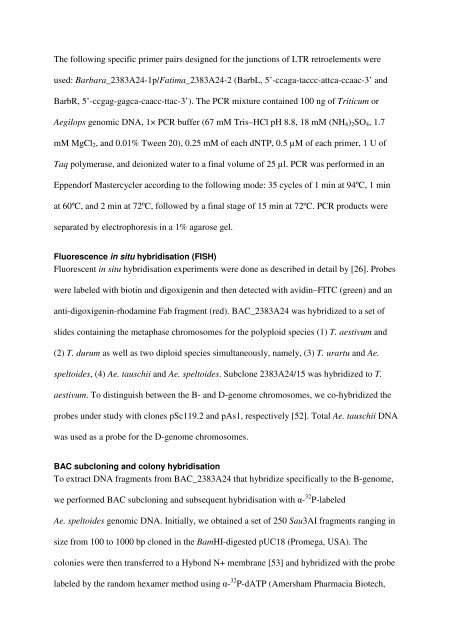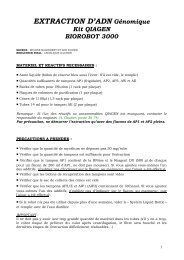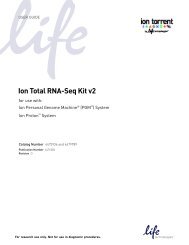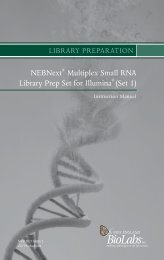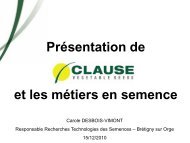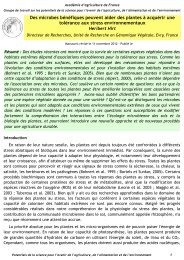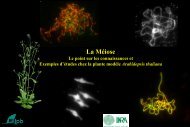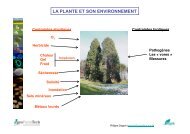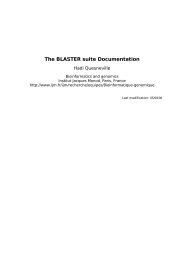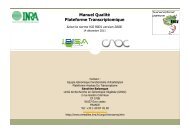The impact of Ty3-gypsy group LTR retrotransposons ... - URGV - Inra
The impact of Ty3-gypsy group LTR retrotransposons ... - URGV - Inra
The impact of Ty3-gypsy group LTR retrotransposons ... - URGV - Inra
You also want an ePaper? Increase the reach of your titles
YUMPU automatically turns print PDFs into web optimized ePapers that Google loves.
<strong>The</strong> following specific primer pairs designed for the junctions <strong>of</strong> <strong>LTR</strong> retroelements were<br />
used: Barbara_2383A24-1p/Fatima_2383A24-2 (BarbL, 5’-ccaga-taccc-attca-ccaac-3’ and<br />
BarbR, 5’-ccgag-gagca-caacc-ttac-3’). <strong>The</strong> PCR mixture contained 100 ng <strong>of</strong> Triticum or<br />
Aegilops genomic DNA, 1× PCR buffer (67 mM Tris–HCl pH 8.8, 18 mM (NH 4 ) 2 SO 4 , 1.7<br />
mM MgCl 2 , and 0.01% Tween 20), 0.25 mM <strong>of</strong> each dNTP, 0.5 µM <strong>of</strong> each primer, 1 U <strong>of</strong><br />
Taq polymerase, and deionized water to a final volume <strong>of</strong> 25 µl. PCR was performed in an<br />
Eppendorf Mastercycler according to the following mode: 35 cycles <strong>of</strong> 1 min at 94ºC, 1 min<br />
at 60ºC, and 2 min at 72ºC, followed by a final stage <strong>of</strong> 15 min at 72ºC. PCR products were<br />
separated by electrophoresis in a 1% agarose gel.<br />
Fluorescence in situ hybridisation (FISH)<br />
Fluorescent in situ hybridisation experiments were done as described in detail by [26]. Probes<br />
were labeled with biotin and digoxigenin and then detected with avidin–FITC (green) and an<br />
anti-digoxigenin-rhodamine Fab fragment (red). BAC_2383A24 was hybridized to a set <strong>of</strong><br />
slides containing the metaphase chromosomes for the polyploid species (1) T. aestivum and<br />
(2) T. durum as well as two diploid species simultaneously, namely, (3) T. urartu and Ae.<br />
speltoides, (4) Ae. tauschii and Ae. speltoides. Subclone 2383A24/15 was hybridized to T.<br />
aestivum. To distinguish between the B- and D-genome chromosomes, we co-hybridized the<br />
probes under study with clones pSc119.2 and pAs1, respectively [52]. Total Ae. tauschii DNA<br />
was used as a probe for the D-genome chromosomes.<br />
BAC subcloning and colony hybridisation<br />
To extract DNA fragments from BAC_2383A24 that hybridize specifically to the B-genome,<br />
we performed BAC subcloning and subsequent hybridisation with α- 32 P-labeled<br />
Ae. speltoides genomic DNA. Initially, we obtained a set <strong>of</strong> 250 Sau3AI fragments ranging in<br />
size from 100 to 1000 bp cloned in the BamHI-digested pUC18 (Promega, USA). <strong>The</strong><br />
colonies were then transferred to a Hybond N+ membrane [53] and hybridized with the probe<br />
labeled by the random hexamer method using α- 32 P-dATP (Amersham Pharmacia Biotech,


